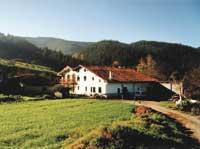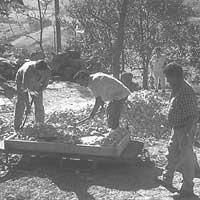The hamlet, refuge of Basque agriculture for centuries
1997/12/01 Bengoa Ansa, Aitor Iturria: Elhuyar aldizkaria
When analyzing the history of agriculture in Euskal Herria, the farmhouse has been an important element. The hamlet can be understood as housing or as an old economic institution. Alberto Santana, in his book “El caserío”, says that if the Caserío is interpreted in the broader economic sense, its origin would be medieval.
In the Lower Middle Ages, the largest social class was that of the peasants, but they were secondary inhabitants and depended on a few gentlemen. Farmers of the time can be classified into three categories. On the one hand were the grandparents' children. They had rights in the land they cultivated and paid no taxes. On the other hand, there were the free peasants or the king's farms.
They also enjoyed autonomy in the lands they cultivated, but they could not give up the exploitation of the hamlet to those who were not their relative, and they also had to pay the king's taxes. Finally, the third group consisted of peasant servants at the lowest level. They had no freedom and could not marry without the permission of the Lord. The medieval hamlets were saddle shacks, the inner skeleton was built with beams and from the outside they had sided walls.

First stone farmhouses, XV. They were built in the nineteenth century and at that time only the rich farmers had economic capacity to build such constructions. In order to build the hamlet, the salaries of the stonemasons had to be paid. Oak wood was free in the village woods.
XVI. In the twentieth century many farmhouses were built, with stone and wood. There are still farmhouses that have been built and are still standing at that time. They are buildings of great value, since in addition to being old, they have carpentry and quality quarry. They were of different types, but they all had two low plants for families and animals and the higher one for harvesting (mainly apples and wheat). Most of the hamlets had a winepress and cellar. In fact, the XVI. The 20th century was a good time for the Basque hamlet.
XVI. At the end of the 20th century, with the crisis of commerce and naval industry in the urban centers, many people began to look at the hamlet and filled all the hamlets. It was often difficult to find land for everyone.
In this situation, and as a miracle, the corn appeared. This yielded more than wheat on the same surface. As a result of the introduction of maize, the wealthiest peasants built new farmhouses to offer them for rent and began planting corn everywhere. The forests and argomal trees were cleaned for the planting of corn and the animals kept longer in the stable. It was sweet moments.
But the wheat did not completely disappear. In fact, the peasants paid the farmers and the church with wheat skins for those who were forced to sow wheat. XVIII. In the eighteenth century began to fertilize the land with lime and the excessive use of lime caused a burning of land on the margins, destroying the best farmland.
XIX. In the 20th century new systems were invented to plow the land, which led to a significant increase in production. XX. At the beginning of the 20th century, with the opening of metal, paper and textile factories, many peasants abandoned the hamlet and its value decreased considerably, so many tenants had the opportunity to buy the hamlet to the owner.

Gai honi buruzko eduki gehiago
Elhuyarrek garatutako teknologia





